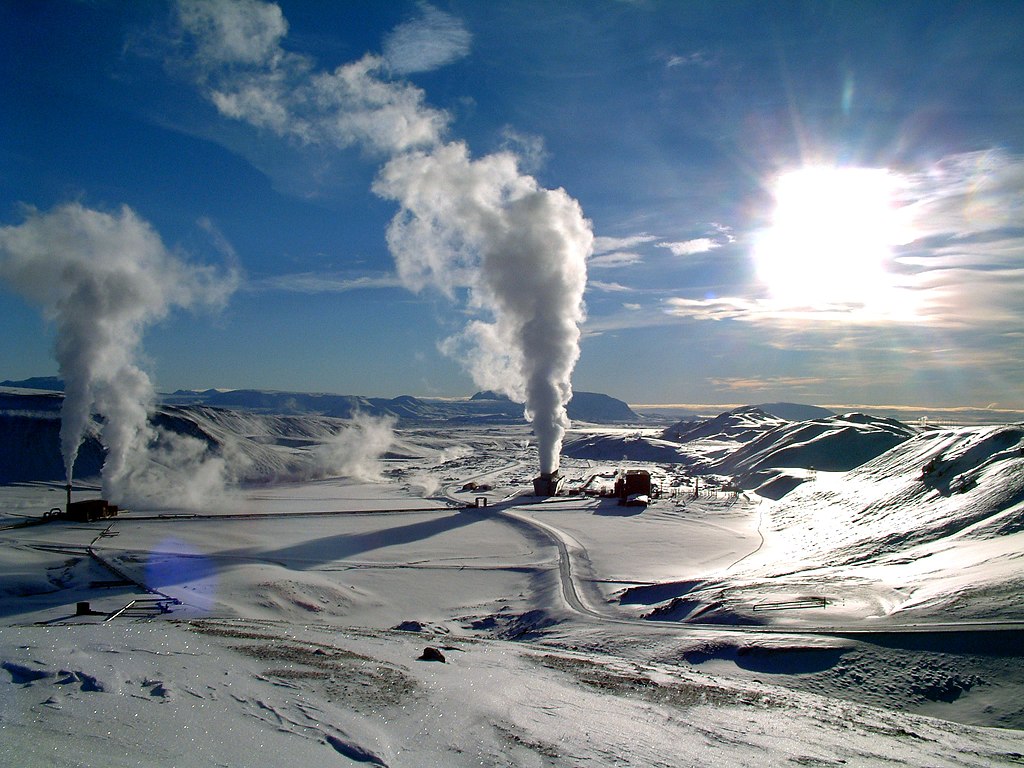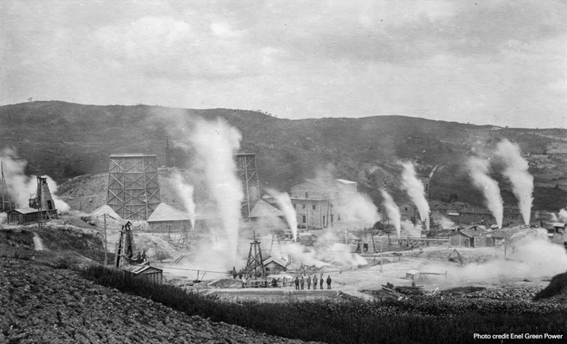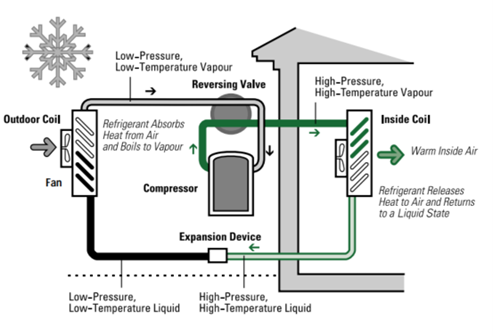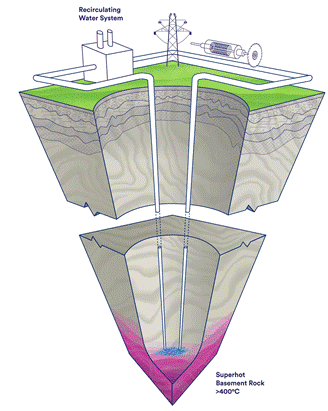
The Krafla geothermal energy plant in Iceland. More than one-quarter of Iceland’s electricity is produced by Kafla and other geothermal plants. Image: Ásgeir Eggertsson
By James Myers
With an increasing focus on renewable energy to address the planet’s climate crisis, attention is turning to large-scale geothermal electrical production as well as the use heat pumps for home heating and cooling.
Geothermal heat exchange systems are also being installed to heat and cool entire city areas, for example the University of Toronto’s largest campus.
Geothermal power plants draw heat from the Earth’s core in wells of steam or hot water that are drilled sometimes as much as three kilometres deep. Requiring heat of between 150 and 400 degrees Celsius to drive turbines that generate electricity, geothermal plants are located in regions with high subsurface temperatures often caused by volcanic activity.
An advantage of geothermal power is that it is continuous and reliable, unlike solar and wind power that fluctuate with weather conditions. Geothermal power originates in the Earth’s core, roughly 2,900 kilometres below the surface where most of the heat is generated by the constant decay of radioactive isotopes. The cost of drilling, however, can be prohibitive, and a number of new approaches aim to make geothermal energy more cost effective.
In 2023, 0.4% of electricity in the U.S. was generated by geothermal plants located in seven states, two-thirds of which were in California and supplied 5.1% of the state’s electrical needs. Globally, volcanically active Indonesia is the largest geothermal electricity producer, furnishing 5% of the electrical needs for the country of 280 million people. Geothermal energy supplies Iceland with more than one-quarter of the electrical needs of the country’s population of 400,000.
Most geothermal electricity is generated in “flash steam” plants, drawing high-pressure hot water from deep inside the earth and converting it to steam that drives generators.

The Larderello geothermal plant in Italy is the world’s oldest, beginning in 1904. Image: U.S. Office of Energy Efficiency & Renewable Energy.
When the steam cools, it condenses to water and is reinjected into the ground for reuse. The Larderello geothermal power plant in Tuscany, Italy, is the world’s oldest, beginning operation in 1904, and an example of a “dry steam” plant that draws steam directly from the ground to power electrical-generating turbines.
Larderello is the world’s second-largest geothermal plant, generating 769 megawatts of electricity capable of powering one million homes.
Producing 900 MW of power, the world’s largest is The Geysers, located in the Mayacamas Mountains in California. The site’s name is a misnomer, since there aren’t actually any geysers to be found there; instead, deep below the mountains is a layer of cracked and broken rock which is heated by magma. When groundwater comes in contact with the rock, it turns into steam and escapes through what are known as fumaroles.

The Geysers, located in California, is the world’s largest geothermal electrical production site. Pictured is one of eighteen power plants at The Geysers. Image: Stepheng3
For individual homes, geothermal heat pumps transfer heat from the ground or water into buildings during the winter and reverse the process in the summer.
Heat naturally flows from higher to lower temperature, and a heat pump uses a refrigerant gas to extract heat from areas of lower temperature (like the air or ground in the winter) and deliver it to a higher temperature location (like a house in the winter). Similarly, in the summer the heat pump draws heat out of a cooled home into the warmer outdoors.
The cost of installing such systems is several times greater than conventional heating and cooling, but the payback period from reduced energy costs could be as little as five years which makes the option attractive for longer-term homeowners.

Diagram of the operation of a home heat pump system in the winter. The process is reversed for cooling in the summer. Image: Natural Resources Canada
What’s in store for the future of geothermal energy?
The use of heat pumps to heat and cool homes continues to expand, particularly where subsidies are available to homeowners to offset the high installation costs.
Electrical production from geothermal sources can be increased by enhancing the flow of hot water and steam with fracturing of the subsurface to create fissures that can hold a greater volume. The process shows promise in recent tests, although new technology will be required to reduce the cost of fracturing.
Another approach is the use of closed loops that pump liquids through the hot rocks underground and transfer the heat to drive generators aboveground.

Superhot rock energy extraction animation from the Clean Air Task Force.
Certain fluids called “supercritical fluids” can retain heat more efficiently than water, significantly improving the output and lowering cost.
One company, Quaise Energy, is exploring the potential to access far greater heat at depths of as much as 20 kilometres, ten times more than the deepest geothermal wells now in production. Quaise uses standard rotary drilling techniques for the first part of their wells, then employs millimetre microwave energy to vaporize the rock below which is cleared by a column of gas. The goal is to reach temperatures as high as 500 degrees Celsius.
Closed loops and extremely deep wells are examples of what are called “superhot rock” (SHR) energy sources. Unlike conventional geothermal systems, SHR operates by injecting water into depths where the temperature exceeds 400°C, transforming the water into a state that combines both liquid and vapor properties and significantly increases energy output by five to ten times that of traditional wells.
A study by the Clean Air Task Force and the University of Twente identified SHR potential across about 9% of Europe’s land area at depths below 12.5 km.
The study concludes that with a concerted focus on deep drilling research and technology innovation, “Just 1% of Europe’s superhot rock resource has the potential to provide 2.1 terawatts of energy capacity, which could generate nearly 18,000 terawatt-hours (TWh) of electricity. Though these numbers are only preliminary, their scale is enormous. To provide perspective, the city of Berlin consumed 12.5 TWh in 2022, so Europe’s superhot rock energy resource capacity could theoretically satisfy the annual electricity demands of over 1,400 additional cities equivalent to Berlin.”
Geothermal is one of a number of promising renewable energy sources, with an advantage of consistency and reliability.
Technological advancements promise to reduce costs and increase efficiency, and although many areas don’t have sufficient underground heat sources for large-scale production there remains widespread possibility for home heating and cooling as well as feeding local electrical production into national power grids.
The future of clean energy could be below our feet.
We would love to hear what you think of this article.
☞ Click here to complete our 2-minute Reader survey.
Craving more information? Check out these recommended TQR articles:
- Progress in Superconductivity Holds Promise for Clean Energy, Medicine, Quantum Computing, and More
- Advances in Nuclear Fusion Technology are Fueling the Dream of Limitless Clean Energy
- Clean Technologies and Technologies That Clean: Undoing the Climate Damage We Have Caused
- Harnessing Ocean Power: New Technologies Hold Promise for Clean and Cost-Effective Energy
- In Wiki Loves Earth Photos, Observers Share a Deep Knowledge of Nature’s Incredible Integration



